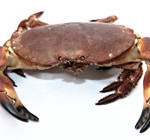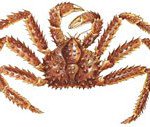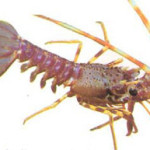
Pecten maximus and Chlamys islandica
Scallops are bivalve molluscs with scalloped, fan-shaped shells (valves) whose shape and colour have inspired artists architects and designers for centuries.
The shells are further characterized by radiating ribs or grooves and concentric growth rings. Near the hinge, where the two valves (shells) meet, the shell flares out on each side to form small “wings”. Just inside each valve along the edge of the mantle there a row of short sensory tentacles and a row of small blue eyes.
A single adductor muscle, sometimes called the ’eye’ in culinary circles, opens and closes the two valves. Because they are active swimmers, the adductor muscle is more developed in the scallop than in oysters and clams. The muscular snapping of the shells togethers generates the propulsion needed for movement through the water. They s feed on microscopic plants and animals.
The great scallop, also known as the king scallop or Coquille St Jacques, has thick, solid shells, with 16 radiating ribs. The left valve is flat and the right shell is quite convex. The right valve is off-white, yellowish, or light brown in colour, often with bands or spots of darker pigment. The left valve is light pink to reddish brown. It rests on the right valve in a depression in sand or fine gravel, from just offshore, to depths of 100 metres. The king scallop can grow up to 15 cm long.
The Icelandic scallop (Chlamys islandica), also known as Queenies, range in colour from brilliant red, purple, orange or yellow to white. The normal habitat is a hard sea bottom at depths of 15-80 m and they are most abundant in fairly strong nutrient rich currents. Queenies grow rather slowly and mainly in the spring and summer months. Ten-year-old scallops measure 6.5-8.5 cm in height. It differs from the king scallop in that it is smaller, with more pronounced grooves.
Low numbers of scallops are, unsurprisingly, indicators of overfishing.








Social Profiles